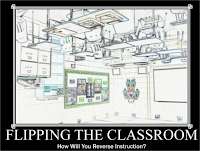Creighton School District’s Project iAchieve
is getting ready to pilot a “Flipped Classroom” model with a middle school math
class. The students will be issued iPads to use for both their homework and in
class work. Yes, that means they will be taking them home. But what is a
flipped classroom?
In a “traditional” classroom, students listen
to a conventional lecture with the teacher sharing the information they need to
know, they might have a few minutes to practice a couple of problems or ask a
question, then they go home and complete their “homework” based upon the
information they heard during the lecture. In the flipped classroom, this
process is flipped, or reversed. Lectures become the homework and class time is
used for student collaboration, interaction with the teacher, practice and
problem solving that addresses a variety of learning styles and abilities. For
homework, students learn the content often through video lectures, many of
which can be created by the teacher. These video lectures can be accessed at
any time and played as many times as needed to learn and understand the
content. During class time, students work on solving problems, asking
questions, interacting with the teacher and other students, and having
misconceptions about the content resolved.
While many think the flipped classroom is
about the videos – it’s not. It’s really about what happens in the classroom
after students have viewed the videos - interactions and meaningful learning
activities that happen during the face-to-face time in the classroom, planned
and facilitated by the teacher. It is about student centered learning, students
taking responsibility for their own learning. The flipped classroom is about
beginning with the end in mind, locating or creating quality learning
resources, and placing the content into context and building conceptual
understanding
In-class learning activities support the
stated learning objectives, help students process their learning, and gives
context to the content through real world scenarios. Students collaborate with
and tutor each other, ask in depth questions, and take ownership of the
content. Learners are actively engaged in problem solving and critical thinking
as they discuss the content with the teacher and each other.
The flipped classroom allows learners to work
both independently and collaboratively – helping each other learn - along with
coaching from the teacher.
The flipped classroom allows learners to
build on their existing proficiencies, interests, and experiences through
extended face time with the teacher and other students. This allows them to
engage in discourse about the mathematical content and resolve misconceptions
as they arise and before they are embedded into memory.
The flipped classroom allows teachers to
ensure that all students are given tasks that help them improve their
conceptual understanding and think with and about mathematical concepts. It
provides many opportunities to “make sense of problems and persevere while
solving them” (CCSS Mathematical Practice).
The flipped classroom utilizes a range of
assessment practices to evaluate student progress in learning and mastery of
the content and to improve curriculum planning. Assessments can include in
class checks for understanding, formative assessment, and teacher anecdotal
data.
Three Part Series of Articles on the Flipped
Classroom:

Comments
Post a Comment